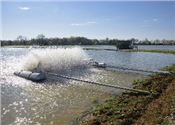Consider Aeration For Summer Pond Health
DR. WES NEAL
STARKVILLE, MISSISSIPPI
Summer has arrived, and your pond is heating up! The surface water of local ponds feels like freshly run bath water, but it gets cold deeper in the pond. In the peak of summer, surface water temperatures in a deep pond can be in the low to mid 90s, while the deepest areas might still be in the lower 70s.
Fish cannot just go deeper to escape the heat because there may not be enough oxygen in deeper water. Oxygen is only produced in the shallow layers where photosynthesis is occurring, and there is not enough sunlight deeper in the pond to allow photosynthesis. On the contrary, animal, plant and bacterial respiration continue using up oxygen.
Therefore, oxygen in deeper layers can drop to very low levels.
Fish get squeezed between the hot surface and the oxygen-deficient depths. This problem is worsened by the fact that less oxygen can dissolve into water as it warms. For example, 60-degree water can hold about 10 milligrams per liter of oxygen, while water in the low 90s can hold only about 7 milligrams per liter. That’s 30 percent less.
To add insult to injury, as temperatures increase, fish require more oxygen for biological functions. So, as water gets hotter, fish need more and more of a resource that is becoming less and less available.
When these two variables clash, fish kills can occur.
Using surface aerators can help resolve low-oxygen situations. A powerhouse-style aerator like the ones used on catfish farms can provide a refuge. In deep ponds, it will not aerate the whole pond or destratify the pond’s temperature and oxygen layering, but it will save fish. Fountains rarely will provide significant aeration of surface waters and will not help fish.
Destratification systems, or bottom plate aerators, will remove the pond’s stratification and provide oxygen at greater depths when properly designed. These systems use rising columns of bubbles to lift cold bottom layers toward the surface. The result is the relative homogenization of temperature throughout the water column, and to a lesser degree, oxygen.
Destratification can have the unintended effect of increasing the overall temperature of the water. When the water is continuously circulating using destratification, there is no surface layer of warm water to insulate deeper, cooler layers, thus all water tends to warm towards the average air temperature. Plus, there is direct solar heating, which is strongest around midday.
A timer can be used to turn the system on at dark and off at dawn.
This provides the benefits of destratification when air temperature is coolest but allows for temporary daytime stratification to form at the surface and help protect the thermal integrity of deeper waters during the heat of the day.
Although there has been no scientific evaluation of the nighttime aeration approach, it seems logical on the surface (pun intended).
Further, research has suggested that destratification makes ponds more productive. So, if it fits your budget, this approach is a good insurance policy against the heat of summer. ∆
Editor’s Note: Extension Outdoors is a column authored by several different experts in the Mississippi State University Extension Service.
DR. WES NEAL: MSU Extension Service

Using surface aerators can help resolve low-oxygen situations in ponds. A powerhouse-style aerator like the ones used on catfish farms can provide a refuge.
File photo by MSU Extension Service/Kevin Hudson